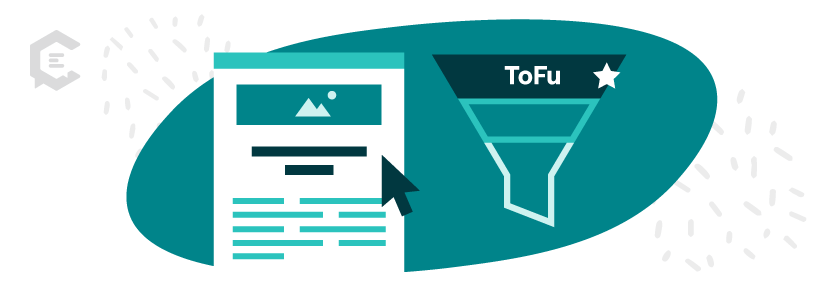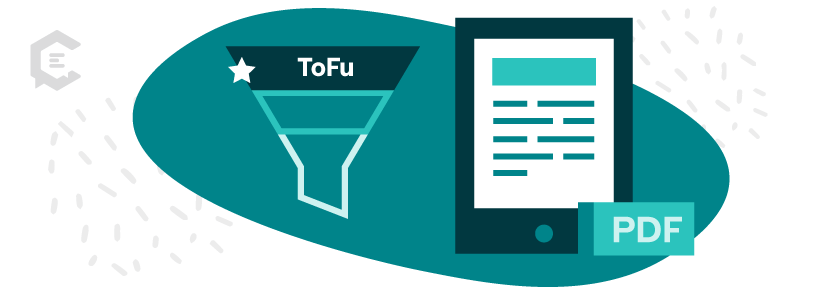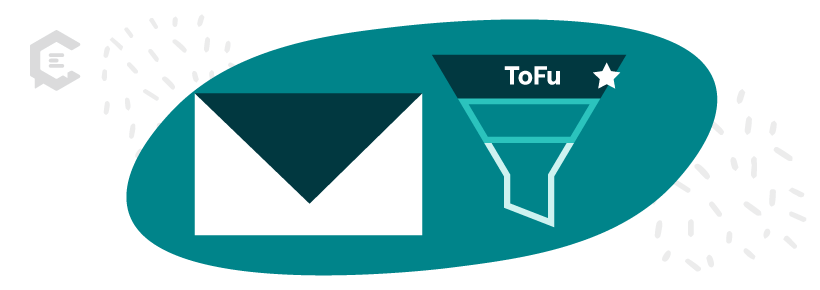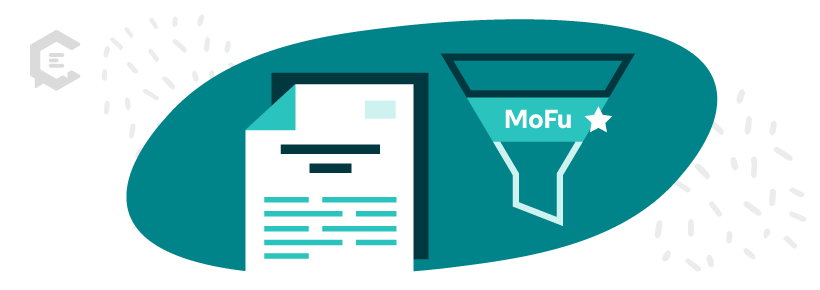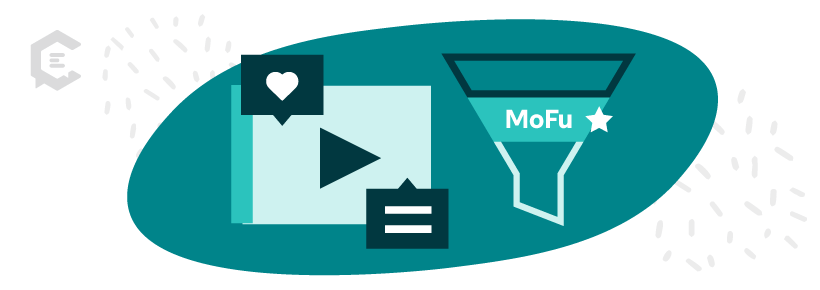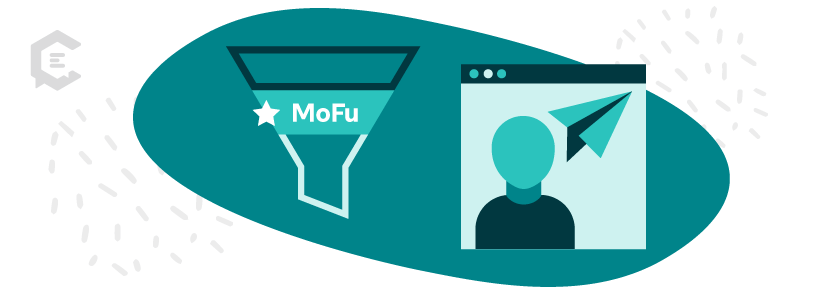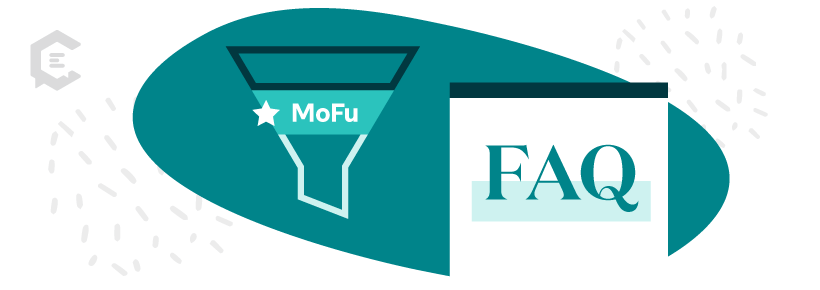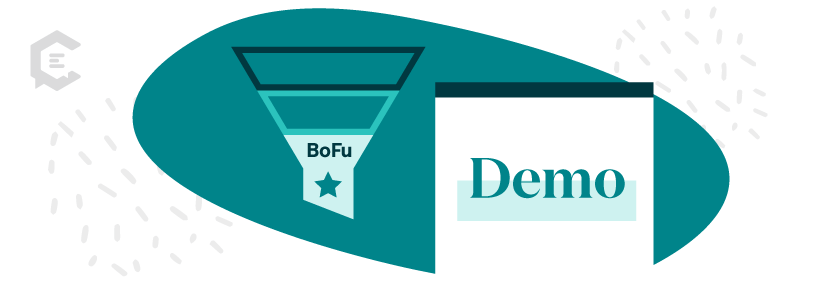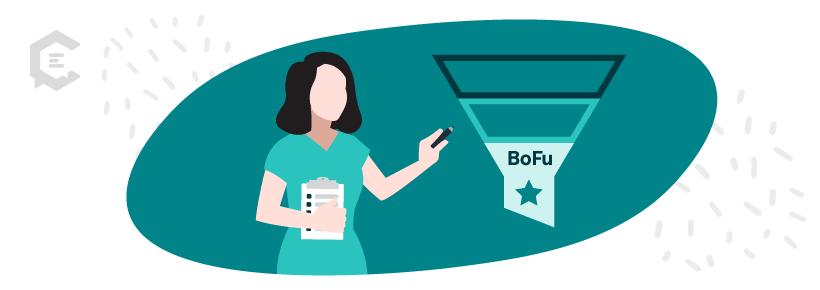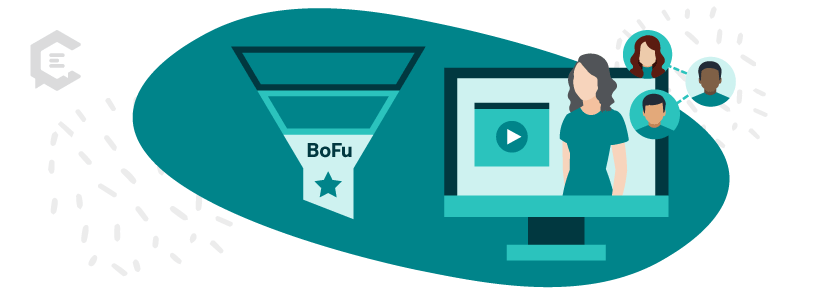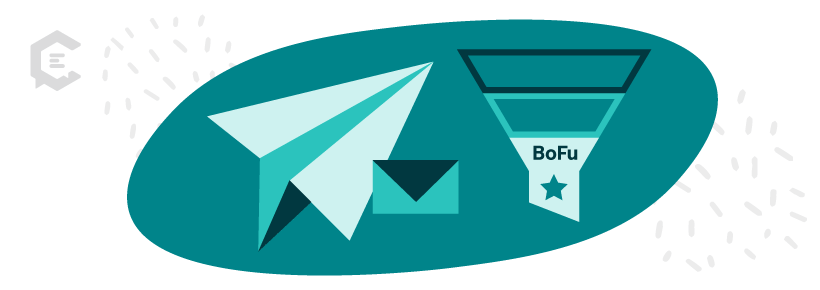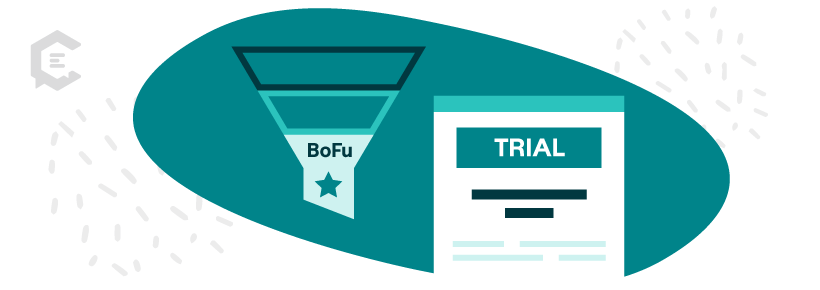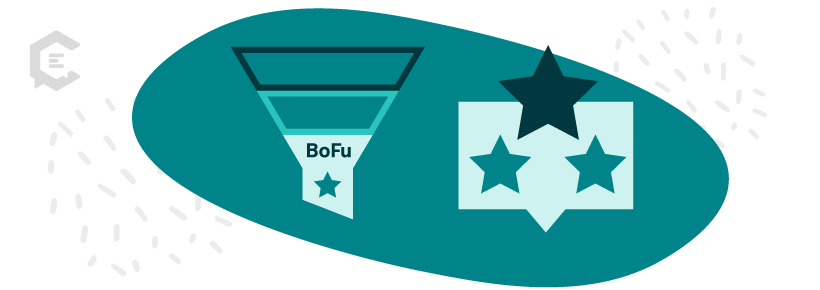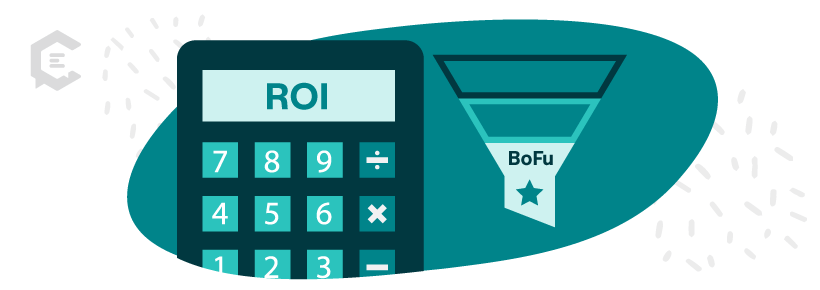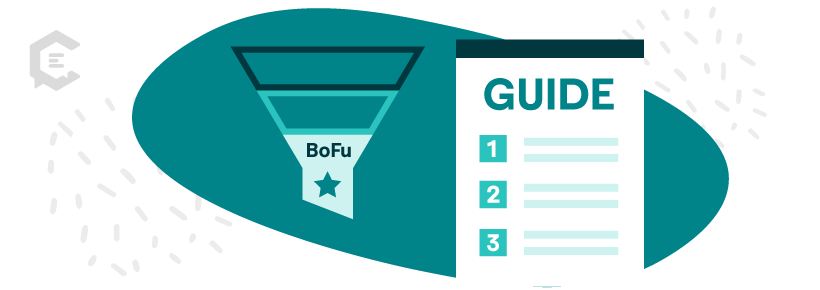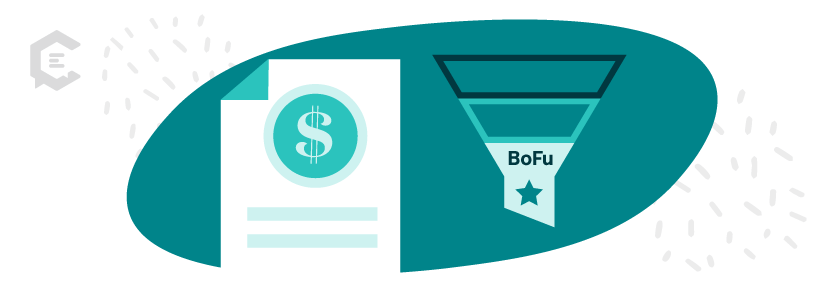Did you know that buyer’s journey content should be different for each stage of the funnel to ensure the best results?
Content marketing is a massive business, with brands spending a considerable amount of their time and budgets making sure they use it wisely.
Unfortunately, creating a lot of content (even great content) and having no idea where it will most impact your customers’ buying journey can lead to lackluster results.
A clear understanding of the marketing funnel and how various types of buyer’s journey content easily fit in can help you avoid costly mistakes and possible alienation of your ideal customer.
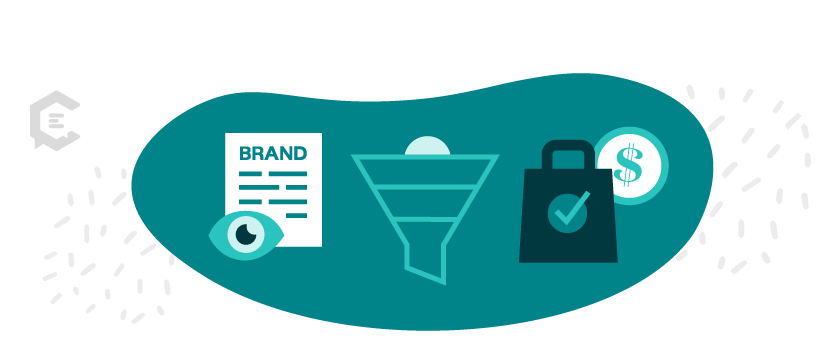
What is a Marketing Funnel?
We can define a marketing funnel as a business strategy that marketers use to guide prospects from initial brand awareness to the final purchasing stage.
It uses different applications at various points based on the prospect’s familiarity, needs, and readiness to buy.
The concept assumes that someone less familiar with your brand will start at the top of the funnel with more generalized information and softer selling while working down to the more targeted sales strategies implemented at the bottom of the funnel over time.
While brands use the terms interchangeably, the content marketing funnel differs from a flywheel. The two can be used together, however.
What Are the Marketing Funnel Stages?
One of the major differentiators of the marketing funnel from other strategies is that it seeks to identify where the customer is in their journey and market to them directly at that stage. Each stage aligns to a place in the marketing funnel: top, middle, and bottom.
While these are the three main stages, each stage can have an additional level of segmentation to further customize content and ensure customers within each stage are getting the right type of information.
A company that wants to explore full-funnel marketing will have a stake in creating buyer’s journey content for each stage.
Top-of-funnel marketing
At the very beginning of the customer journey is awareness, or coming to know about a brand’s existence. This is considered the top of the funnel (ToFu), and it’s where you lay the groundwork for telling the customer who you are, what values you hold, and the possibilities you offer through your buyer’s journey content.
Top-of-funnel marketing requires the least knowledge about a brand or offering, making it an ideal marketing content task for agencies and freelancers who don’t live and breathe your brand every day but who can quickly get up to speed and use their skills to make a compelling introduction.
Top-of-funnel marketing assumes that not everyone will be the ideal buyer. It is willing to reach out to almost everyone, making the top of the funnel very wide, very welcoming, and very well-suited for SEO strategies.
Anyone who can perform a search may be placed at the top of the funnel to see what your brand is about, even if they aren’t exactly who you hope to sell to later.
Middle-of-funnel marketing
Further into the buyer journey is where the middle-of-funnel marketing (MoFu) happens. This assumes the buyer is at least somewhat interested in pursuing a professional or consumer relationship with your brand, and this is where they spend the most time in pursuit of facts or benefits that can help them make a buying decision.
Because the buyer’s journey content types here will be more detailed, brand-specific, and with solutions to customers’ needs in mind, the guidance of a subject matter expert (SME) can come in handy.
If you choose to outsource this content, freelancers with established writing clips in your industry or who are themselves SMEs can ensure the quality of work you need to engage and inform your prospects.
Bottom-of-funnel marketing
Finally, at the point where a buyer is likely to make their purchasing decision, you have bottom-of-funnel marketing (BoFu.) This is where the “rubber meets the road,” so to speak, and you’ll see your work to this point result in some type of action.
Bottom-of-funnel buyer’s journey content isn’t limited to asking for the sale and closing the deal. It’s where you can continue to nurture your leads, who are now buyers, by:
- Confirmation: “You’ve made a great decision. Welcome to the family!”
- Onboarding: “Here’s how to get the most out of your product.”
- Support: “We’re sure you have questions. Get answers here.”
- Reconfirmation: “Here’s why you made the right choice in choosing this over our competitors.”
- Solution-based cross-selling: “You might also like this to make your experience better.”
Because bottom-of-funnel content brings the customer into the sphere of being “in the know,” this content is best written by someone who works for the company or brand since it requires the most intimate knowledge of the product and what it offers.
Do you absolutely have to do bottom-of-funnel content on your own? Not necessarily. Freelancers who previously worked for your company may also fill this role. Other possible arrangements include having an agency help with concept and final development, such as editing, creating graphics, or content syndication.
Boost conversions at each stage of the sales funnel with our in-depth guide!
What Types of Buyer’s Journey Content Do I Use at Each Stage?
As you can imagine, a complete marketing sales funnel can contain dozens or even hundreds of pieces of content. Every written word supporting a marketing campaign will fit into that funnel somewhere, with some pieces straddling two parts of the funnel or even being repurposed to meet two places in the customer journey.
That said, some buyer’s journey content pieces are going to work best in specific parts of the funnel. Keep in mind that there is some wiggle room here and that certain content formats are close enough to other formats that you may simply be using semantics to distinguish one from the other.
(Case studies and white papers are good examples of two types of content that can meet the same goal, look a lot alike, and can be used interchangeably. The goal of each is what matters most here.)
Top-of-funnel content types
This buyer’s journey content may be the first a prospective client has ever heard of you. It may also be where you first let them know of a problem you help to solve. Prior to the top of the funnel, the prospect may not only be unaware you exist, but they may not even be aware that they need your service or product.
Blog posts
Your company may already be creating blog posts, as they are among the easiest types of content to start producing right away. At this stage in the digital marketing funnel, your blog posts should be educational and evergreen.
What do we mean by this? Start by asking the following questions to narrow down possible blog post topics:
- What would we want people to know about us first, especially if they have never heard of us before?
- What solution do we offer that may be new to the reader or visitor? How can we best explain it in a way that’s accessible to everyone?
- What are our more established competitors known for? How might someone searching for them (but who ends up on our site) see us as different and relevant?
- What notable trends in our industry are interesting or applicable to the common person? How can we turn that into a list or topical guide to make them feel informed after reading it?
- What search terms are we already seeing traffic for? How can we create content around those questions that position our brand as an authority on the matter?
- What search terms do we want to see traffic for? What terms are supposed to lead people to us, but we have yet to create optimized content that attracts and informs?
Your blog posts at the top of the funnel should educate, build interest, and place you as an expert on the topic at hand. This is not the place to create a hard sell. At a minimum, the readers should come away from your blog post thinking, “That was valuable, and I’ll remember that brand for having shared it with me.”
eBooks
EBooks are another “catch-all” buyer’s journey content bucket that can have very different goals based on your company’s unique needs. They range in word count from a few pages to hundreds of pages (the size of a traditional eBook), but most organizations aim for shorter, more concise formatting with infographics, stats, and call-outs to keep the content lively and to help pull the reader through the pages easily.
What top-of-funnel uses do you have for an eBook? The possibilities are endless, so ask these questions to get you started:
- What industry tips or tricks do we have to share with our readers?
- How can we empower them to continue researching a topic through our eBook content?
- What eBooks have our competitors created? What enhancements can we include to make ours the best, most updated, or most authoritative on that topic?
- Is there a common “how to” answer that isn’t easily covered in a single blog post? Would this topic make a good guide or manual that we can market in eBook form?
- Do we have an existing series of related blog posts that we can stitch together and update for an insightful, content-packed eBook?
These are just a starting place for your eBook topics. Once you have identified a few options for topic and content, consider how to best get that info out there. Unlike blog posts, which get massive traffic from searches, your eBook will need to live on your site as a download or be delivered through an opt-in lead magnet.
Use the ultimate goal of your eBook to drive your decisions here. (A goal to boost your email list, for example, benefits more from having your eBook as an opt-in welcome gift. Share your eBook strategically.)
Email marketing
Do people still read emails? According to the Content Marketing Institute, 81 percent of B2B marketers say their most used form of content marketing is email newsletters.
When used with high-quality buyer’s journey content (like that eBook we mentioned), you can easily build your list of interested subscribers. Just remember to keep these “top of funnel” subscribers in their own list through segmentation.
You won’t be sending out the same emails to those who are merely interested as those who have been loyal to your brand for some time.
Questions to ask about email marketing include:
- What would we want people to know about our brand right now? How can that be condensed into a quick email with a link to more information?
- What new offers or news updates apply to those just learning about our brand?
- How can we use the email experience to set proper expectations for our brand tone, style, offerings, and customer service experience?
- What can we say in the first few emails to remind people of how they found us (why they are receiving these emails), why they want to stick around, and what they would be missing if they unsubscribed?
It’s common for top-of-funnel email subscribers to opt out soon after receiving their lead magnet freebie. By keeping this segment separate, you’ll preserve your email open and click-through rates and have a dedicated channel of communication for those who need additional guidance to know you better.
Middle-of-funnel content types
It’s sometimes assumed that the middle of the funnel is where a prospect goes after they’ve been through the top of the funnel, and this is sometimes the case.
Often, prospects start in the middle of the funnel, as they may already be familiar with the brand or offering and are ready to take their research and understanding to the next level.
The following buyer’s journey content types work well for middle-of-funnel marketing.
White papers
Similar in length to eBooks but created with more data, professional tone, and subject matter expertise, the white paper is a go-to for B2B marketing funnels. They are more likely to be used for enterprise offerings and not items marketed to individual consumers.
You may be an ideal fit for white papers if you can answer “yes” to the following questions:
- Do we have a new product or service that’s difficult to explain in a short-form piece of content?
- Have we commissioned studies, reports, or other data-backed articles that would help support a future white paper?
- Do we have a recent history of upward successes that are easily documented through numbers or stats?
- Is our ideal client someone in the sciences, trades, technology, or an industry where outside expertise is valued?
- Do we have a direct line to decision-makers who are interested in learning more about their industry?
White papers also make great lead magnets for your B2B marketing funnel. Just make sure to use gated methods for delivering the buyer’s journey content. You want the content to feel exclusive and targeted and not available to just anyone.
Social media
Social media may not be considered a middle-of-funnel strategy since it’s easy for anyone (even unqualified leads) to see your social feed. When executed well, however, it’s the perfect place to help prospects learn what makes you special.
Use these questions to determine which social channel is best suited for your marketing funnel:
- What social channels are we already using well? Do we have an established voice that we can build upon?
- What are other companies in our industry using? For example, if a brand markets to Millennials and is on Snapchat, do we need to be there, too?
- Do we have existing relationships with any influencers using channels?
- How does our target market use social today? Where are they primarily located?
While social media strategy is an entire subject in itself, knowing where to begin can save you time and frustration. Spend these moments to figure out how your funnel best works on social.
Drip campaign emails
How do drip campaigns differ from your average email campaign? For one, they are perfectly timed to hit customers at certain places in the buying journey according to that customer’s actions or interests and not necessarily the overall content calendar.
These questions can help you determine if you’re missing out by not using drip campaigns as buyer’s journey content:
- Do prospects generally perform a particular action before becoming a customer, such as requesting specific information or learning about a new offering?
- Do we have a library of content that would be useful at various points in the customer journey? If not, could we create one?
- Do we have data on our customers we can use to trigger email actions? If not, what can we do to collect that data?
- Is our ideal customer base using email over other communication methods, such as social media or online chat?
Drip campaigns take a bit of strategy to pull off because you need to understand your customer behavior, what motivates them, and how your content can align with those actions. When implemented properly, however, there’s no substitute for an email that seems to appear in an inbox at exactly the right time.
FAQs
It may be hard to think that people will still have questions after making it this far into your sales funnel, but those reluctant to buy will always find something to ask.
Beat them to the punch with pre-written answers to common questions that decision-makers at this place in the journey are likely to have. Be creative or even clever with your questions and answers, but be sure their questions get addressed.
Questions to ask with any of these buyer’s journey content types will vary by type, but keep the following in mind:
- How can we differentiate this content from the top or middle of funnel content? What specific calls to action can we include to help make this content stand out as a decision point?
- In what ways can we cross-purpose this content to become more than one content type? For example, can we take the transcript from the webinar and create a white paper or blog post series for it?
- What are the next steps if a prospect doesn’t engage with this content in the way we hope? Do they back into the funnel at a higher point?
Bottom-of-funnel content types
Bottom-of-funnel buyer’s journey content can effectively pull those final levers that turn a looker into a buyer. Because content at this stage is often very detailed, technical, or brand-aligned, it may work best to have internal stakeholders at least be part of the planning process, even if you do outsource much of the written word.
Questions to ask when creating content for bottom-of-funnel will vary by your offering and content type, but they include:
Here are the most common ways to connect with customers in this final part of the funnel:
Product Demos
For some products or services, you have to see them to believe them. Demonstrations take much of the mystery of how things work, giving customers confidence in what they buy.
Demonstrations are moving away from in-person and becoming increasingly virtual, including “walk-through videos” and live, online videos through social media.
Case studies
Do you have a history of delighted customers who would sing your praises? Are you often getting leads by referral? You may have found your next middle-of-funnel marketing piece in case studies. While these take a while to put together, their ROI is hard to ignore.
Ask yourself these questions to determine your case study’s next steps:
- What clients can we ask to interview for a case study? What incentives can we provide to motivate them?
- How have other companies in our industry used case studies?
- What one objection do we hear from those who decline our offerings? Is this something we can overcome through client testimonies?
Case studies are an incredible asset in dealing with clients who don’t want to be the first to try new offerings. If someone else has “gone first,” it takes away some of the perceived risks. Consider case studies when rolling out updates and to help promote product launches to the general public.
Webinars
While a webinar is always a great avenue for gaining interest, webinars at this level of the funnel should be presented as if the attendees are all serious buyers.
Webinars work well for B2B buyer’s journey content like high-end luxury goods that can’t be seen in person and solution-based sales. Be sure to include time for Q&A, a highlight of webinars for many attendees.
Nurture sequence emails
Yes, there’s that email again. As you’ve guessed, email is appropriate at every stage of the funnel, although bottom-of-funnel messages should be precise, targeted, and include links and embeds to other items on this list.
Offer to schedule a demo, personalized assessment, or call over coffee. This is an effective method to ask for that final meeting where the sale will likely be made.
Free trials
Free trials are tempting because they offer customers to see under the hood without a long-term financial commitment.
Even if your trial is a scaled-back or “lite” version instead of a shortened full-feature preview, you’ll give your customers the experience needed to give you a final yes or no with this buyer’s journey content type.
Reviews
Reviews are absolutely necessary to stand out among your competition.
For local businesses, Google explains that reviews in Google My Business can help your visibility (ranking) in the local pack area of search results: “High-quality, positive reviews from your customers can improve your business visibility and increase the likelihood that a shopper will visit your location.”
ROI calculator
Just how much can your customers save? Calculators are an easy win to get customers more interest in a bottom line than anything else.
If you don’t offer the lowest price on the market, be sure your calculator figures in things of added or intrinsic value to make up for the difference.
Implementation guide
A common obstacle to sales is the old question, “How will I use this thing?” Whether people have technical confusion or are just having a hard time imagining your solution in their lives, an implementation guide gives them assurance in this area.
Pricing sheet
If you’ve held your prices pretty close to the vest up until now, the bottom of the funnel is an appropriate time to take the veil off your pricing schemes.
In fact, you don’t have to give them exact prices; a general guide will do. Make them feel that they are at least getting further in their fact-finding mission.
Boost conversions at each stage of the sales funnel with our in-depth guide!
How SEO Fits Into Buyer’s Journey Content
Do you know how valuable Google can be for your inbound marketing funnel? It’s actually quite amazing. SEO plays an important role in each part of the funnel and your buyer’s journey content — but not necessarily in the same way in each place.
Using targeted search terms in all your content ensures that you reach the right audience no matter how your leads find you.
Pay attention to how language changes as a prospect moves through the funnel, and adapt your message (including search terms) to match.
A top-of-funnel search may include the phrase “What is metal roofing?” while a middle-of-funnel lead may ask, “How long does it take to install metal roofing?”
A deep understanding of the customer journey is key here. Knowing the different needs at various marketing funnel stages can help you both win the search engine game with more spots on the leaderboard and get leads into the right place in the funnel.
Placement in Your Buyer’s Journey Content Matters
While there are dozens of buyer’s journey content options you can use to reach your ideal customer, knowing where they work best inside the marketing funnel can help you maximize every word.
ClearVoice and its team of 4,000+ experienced freelancers who specialize in 200+ industries are ready to help you create a content plan for success. Talk to a content specialist today to get started.
Boost conversions at each stage of the sales funnel with our in-depth guide!



